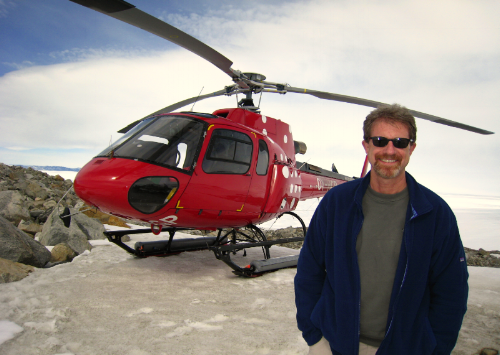4 min read
Greenland is not green. It’s white, covered with a gigantic sheet of ice - 660,000 square miles - roughly a quarter the size of the U.S. Incredibly, this ice sheet also rises one and half miles into the sky.
This is a lot of ice. If you were to crack this massive ice sheet down into actual ice cubes, they would stretch all the way to Alpha Centauri, the nearest star system in our galaxy.
Not really. I just made that up. But can you imagine just how much ice we’re talking about? If the entire Greenland ice sheet melted, the world’s oceans would rise twenty-four feet. And I’m not making that up. This then, is approximately what would happen to the world’s coastal cities:
- Ciao, Miami
- Fuhgeddaboudit, New York
- Au revoir, New Orleans
- Alvida, Mumbai
- Sayonara, Nagoya
But could that really happen? Could that much ice melt away?
I was there… and I saw it. It was definitely melting – on the roads, the hillsides, revealing fresh patches of dirt - rivulets and rivers of newly released water, soaking the land and running into the sea.
Now… this was June so this melting business could have been just a seasonal thing, like the always-present summer sun. But no, the residents told us, they had never seen melting and runoff like this.
Our guides took us touring on the coastal waters and we saw a lot of calving of the ice. That’s when giant slabs of ice, one the size of Manhattan, split off from the towering glacier walls. This is sometimes caused by the underlying ice melt.
The ice tumbles down into the sea with a majestic crash. Followed by spray, waves and a beautiful new iceberg. The sound echoes throughout the bay – like a thunderous call for help.
A Winter Wonderland
I’ve never been to Iceland and I’m sure the ice there is also awesome. But the thick blanket of ice that lays upon Greenland like an ancient comforter, is its essence.
There are many kinds of ice to play with and explore here – glaciers, icebergs, the snow-pack - much of 100,000 years old.
Ever put a 100,000-year-old ice cube in your drink? It’s been under pressure so long, it crackles like Rice Krispies as it melts, releasing air from eons ago. The ice has a nice, ageless bite to it. It’s the refreshing taste of the Paleolithic era.
People come to Greenland to experience the ice in its many forms. There’s dog-sledding, snowmobiling, heli-skiing, snowshoeing and of course, ice golf. The world championships are held here in Uummannaq, the northern most golf course in the world. But don’t bring your graphite clubs - the shafts will shatter in the frigid temperatures.
We had come here to video the spectacle of Greenland – the drama of its unending white horizon and its deep blue icy bays and inlets.
Getting There
Getting to Greenland was actually pretty easy at the time. All you had to do was go to Maryland, to the Baltimore/Washington airport and catch an Air Greenland flight. There was one a week.
Every Wednesday.
Then, stretch out. This was a full size airliner but there were only about ten of us on board - the six of us and also a few people from the National Geographic Society.
I liked the fact we were sharing the big, empty plane with this crew from National Geographic. These guys were serious explorers. Hanging with them made me feel very elite. Like we were all on special assignment.
But in fact we were. The Nat Geo guys were going out to record the ice melt and so were we. Of course, we were also there to do promotional work for our clients - Greenland Tourism and a Vodka company that gathered icebergs to make their spirits.
Contact: Kangerlussuaq
Completing my Special Ops fantasy, we flew into Kangerlussuaq Airport, formerly an old US airbase, in the southwest tip of the island. The largest airport in Greenland, the place is really just a big airstrip cut into the frozen, barren tundra - the only color in sight provided by our bright red Air Greenland plane.
We went to the airport cafeteria for dinner but I didn’t feel up to ordering the musk ox steak on the menu. I usually have my musk ox with a Château Mont-Redon, Côtes-du-Rhône Rouge. But they only had Mountain Dew here. Another time perhaps.
Then, as an extra treat, we spent the night in a converted barracks from the Cold War era. This just added to the adventure/sleep away camp aspect of the journey. It was here in these sparse quarters we got our first exposure to the mid-night sun.
At this time of year, this far north, the sun is up for about 22 hours a day - setting around 11:30 pm, followed by sunrise 2 hours later at 1:30 am. With dawn quickly taking over dusk, it never gets dark.
For those who find comfort in the layers of the dark night, I can tell you Greenland in the summer is not your kind of place. On the other hand, you may want to try it out in December, it's always night at that time of the year - just don't get too depressed.
Meanwhile, at Camp Kangerlussuaq, they gave us nightshades to fight the ever-present light. I hung onto these.
So, very bright and early the next morning we hopped on a little prop plane to wing us into the smaller airport at Nuuk, the capital city. Nuuk boasts the only escalator in Greenland, also the only two traffic lights on the giant island. I could see them both from my hotel window.
But there really wasn’t much traffic. I’m not sure these traffic lights were even needed. Perhaps they were more a point of civic pride than necessity.
It was quite easy to get around Nuuk despite a lack of public transportation. We just walked. In about 15 minutes, we could get to the parliament, a school, restaurant, or the escalator…
However, wherever we went we could see the melting and the runoff. There was always water underfoot. The pavement was continuously wet – a reminder that the ice surrounding us was melting. In fact, it was melting faster than has ever been recorded.
The locals confirmed this, and despite their friendly and welcoming manner, shared their concerns that trillions of tons of ice from their land had disappeared. These changes have already disrupted the hunting and fishing that have sustained these native Inuit people for thousands of years.
The population here also has a sprinkling of Danes, as Greenland lies within the Kingdom of Denmark. The histories of the two countries have been intertwined for hundreds of years and Greenland has enjoyed autonomous rule since 1979.
A member of the European Union, Greenland split off from that notable body, foreshadowing Britain’s Brexit, with their own 1985 Grexit or Greexit. Or Greenxit. Something to do with fishing rights.
The Greater Nuuk Area
My client, Greenland Tourism asked us for aerial shots of the sweeping ice fields. This was a great opportunity to promote the country’s austere beauty and perhaps collect some visuals for an effective ‘Help’ campaign.
So we piled into an Air Greenland helicopter for a day trip over the ice. Our young pilot said we could fly wherever we wanted. This was a challenging assignment as it was milky white in every direction. Sort of like flying over the middle of the ocean. But frozen.
As our eyes got used to the white light of the gleaming ice below, we could see all sort of shapes, patterns, peaks and protruding spires - like a beautiful white dessert topping, all whipped up. We had ourselves a video feast.
Our pilot asked if we'd like to set down somewhere on the ice. Anywhere we liked. I scanned the terrain below. There was no sign of man... or animal or life.
So where was an interesting spot? Where would be a fun place to explore that no man had walked in perhaps a thousand years?
I suppose one couldn’t make a mistake in choosing a spot. It was all pristine. Unless…. you happened to pick a spot where the ice was unstable and would crack upon our landing, flipping the chopper over.
Then the spinning blades would strike the ancient blue/white ice and shatter into a thousand piercing shards. I suppose the chopper itself would explode into a fiery ball and fully engulf us in a hellish eruption of scalding fire and icy shrapnel
But other than that, all the landing possibilities looked quite inviting. Actually very pretty.
So I pointed to a nice, hopeful spot and we gently set down. We were accepted. We stepped out onto the clean, frosty surface. Our boots brought a crunching new sound to the snow-pack that had never been heard. Along with our voices. There was no one and nothing here but us.
Which brought up a crazy thought: we might be the first and only humans to tread this particular spot since the beginning of our planet. This was a possibility in this very remote place.
It was also too much responsibility. We had already messed things up with our presence. With our picture taking. With our helicopter!
Taking in this endless stillness, I was overwhelmed at how welcoming and forgiving our planet is. Despite all the crap we throw at it. It continues to host us even as it struggles to regenerate and survive.
We wake up morning after morning and our home embraces us despite the insults we inflict on it during our day. Like a wise parent with an ever-unruly child, our world patiently waits for us to grow up. We are so lucky.
On The Blue Rocks
At the end of our Greenland trip, we took a little cruise on the bay with our hosts. We came prepared with bottles of Scotch and ice buckets. We would be having 8-year-old Scotch on the rocks - 100,000-year-old rocks – plucked right from the floating icebergs, as we sailed by.
We savored our Scotch in the chill June air, towering white spires all around us. Then we freshened our drinks, harvesting more of the sparkling blue ice into our tumblers. There, melting in the golden pool of fermented barley, the ancient ice would fizz, crackle and sputter as if it was talking to us.
Better than that, it was singing to us. Just one of a million earth songs we can hear every day.
There are lullabies all around us. Wind, ocean, forests… even ice. Our planet cradles us because it loves us. For the time being, anyway, we are so lucky.
Jon Lapidese is a travel copywriter and blogger.








